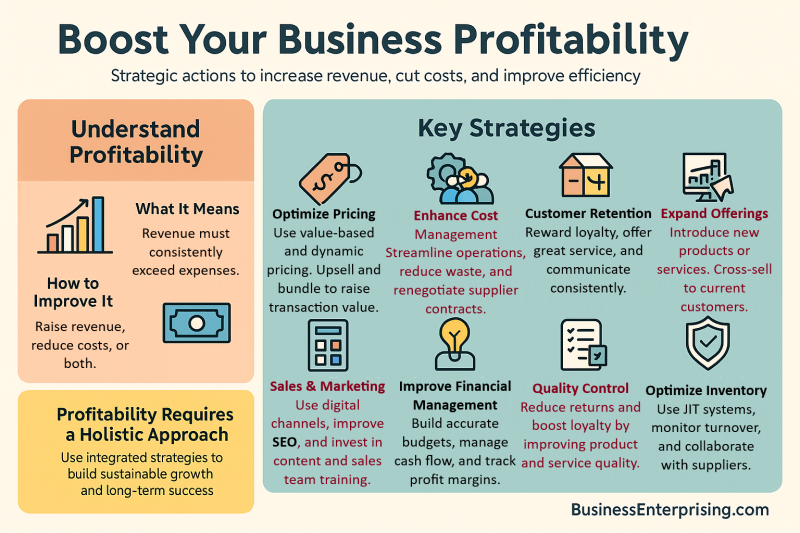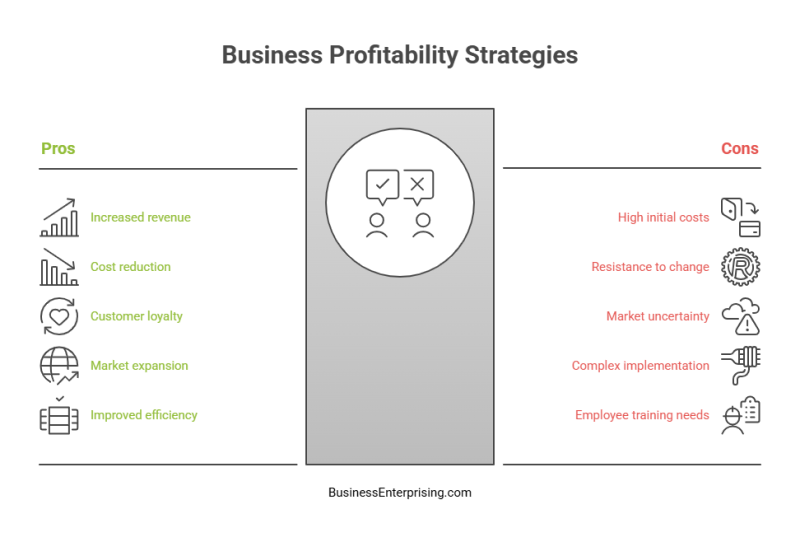
Understanding Profitability
Before getting into strategies, it’s important to understand what profitability entails. Profitability is the ability of a business to generate more revenue than expenses over a specific period. It is a key indicator of financial health and also sustainability. To increase profitability, businesses need to either increase their revenue, decrease their costs, or ideally, both.
Strategies for Increasing Profitability
Optimize Pricing Strategies
One effective way to enhance profitability is by optimizing pricing strategies. Setting prices based on the perceived value to the customer, known as value-based pricing, can justify higher prices and increase profit margins. Additionally, dynamic pricing, which involves adjusting prices in real-time based on demand, competition, and market conditions, can help maximize revenue during peak periods and attract customers during slower times. Bundling products or upselling complementary services also encourages customers to spend more, increasing the average transaction value.
Enhance Cost Management
Enhancing cost management is another crucial aspect. Businesses should streamline operations by identifying and eliminating inefficiencies. Automation and lean management techniques can significantly reduce waste. Regularly reviewing and renegotiating contracts with suppliers can secure better terms and prices, leading to cost savings. Monitoring and controlling overhead expenses such as rent, utilities, as well as administrative costs can further reduce unnecessary expenditures. For example, remote work options can minimize office space requirements.
Focus on Customer Retention
Focusing on customer retention is often more cost-effective than acquiring new customers. Implementing loyalty programs rewards repeat customers and encourages them to continue doing business with you, increasing their lifetime value. Providing exceptional customer service enhances satisfaction and loyalty, making customers more likely to make repeat purchases and recommend your business to others. Regular communication through newsletters, emails, and social media keeps customers informed about new products, promotions, and updates, fostering loyalty.
Expand Product or Service Offerings
Expanding product or service offerings can open new revenue streams and attract a broader customer base. Product innovation, driven by customer feedback and market trends, helps meet changing needs and stay ahead of competitors. Entering new markets or segments through thorough market research identifies opportunities and tailors offerings to different customer groups. Cross-selling related products or services to existing customers increases sales and enhances satisfaction by providing comprehensive solutions.
Sales and Marketing
Investing in marketing and sales is essential for driving revenue growth. Digital marketing channels such as social media, email marketing, and search engine optimization (SEO) allow for targeted and cost-effective campaigns, reaching a wider audience. Creating valuable content through content marketing builds brand awareness, attracts new customers, as well as nurtures existing ones. Training your sales team improves their skills and effectiveness, enabling them to better understand customer needs, close deals, and drive revenue.
Improve Financial Management
Sound financial management practices are crucial for maintaining and increasing profitability. Developing detailed budgets and financial forecasts helps plan and monitor financial performance. Regularly reviewing and adjusting budgets can control costs and allocate resources effectively. Ensuring adequate cash flow to meet operational needs through efficient management of receivables and payables, and considering options like lines of credit for additional liquidity, is vital. Analyzing profit margins regularly identifies areas for improvement and focuses efforts on high-margin offerings.
Leverage Technology
Leveraging technology can significantly improve efficiency and profitability. Implementing Customer Relationship Management (CRM) systems manages customer interactions and data, enhancing service, sales, and marketing efforts. Enterprise Resource Planning (ERP) systems integrate and manage core business processes, enhancing efficiency, reducing costs, and providing valuable insights for decision-making. Data analytics offers insights into customer behavior, market trends, and operational performance, optimizing processes and driving profitability.
Enhance Employee Productivity
Enhancing employee productivity contributes significantly to profitability. Investing in training and development programs enhances skills and knowledge, making employees more efficient and effective in their roles. Fostering a positive work environment promotes engagement and satisfaction, motivating employees to be more productive as well as committed to the company’s success. Implementing performance-based incentives rewards high performers, driving productivity and improving overall business performance.
Optimize Inventory Management
Efficient inventory management reduces costs and improves cash flow. Implementing Just-In-Time (JIT) inventory systems minimizes excess stock and reduces storage costs, ensuring inventory levels match demand and reducing waste. Regularly analyzing inventory turnover rates identifies slow-moving or obsolete stock, optimizing inventory levels and freeing up cash. Building strong relationships with suppliers ensures timely deliveries and favorable terms, maintaining optimal inventory levels and reducing stockouts.
Quality Control
Maintaining high-quality products and services is essential for customer satisfaction and profitability. Establishing robust quality control processes ensures products and services meet customer expectations, reducing returns, complaints, and warranty costs. Regularly gathering and analyzing customer feedback identifies areas for improvement, addressing quality issues promptly to enhance satisfaction and loyalty. Fostering a culture of continuous improvement encourages employees to identify and address quality issues, leading to better products, services, and profitability.
In conclusion, increasing profitability requires a multifaceted approach that involves optimizing pricing, managing costs, retaining customers, expanding offerings, investing in marketing and sales, improving financial management, leveraging technology, enhancing employee productivity, optimizing inventory management, and focusing on quality. By implementing these strategies, you can achieve sustainable growth, competitive advantage, and long-term success. Transitioning to a more profitable business model involves commitment and continuous effort, but the rewards are well worth it. By staying informed, embracing innovation, a swell as maintaining a focus on excellence, businesses can unlock new opportunities for profitability and thrive in today’s dynamic market.


